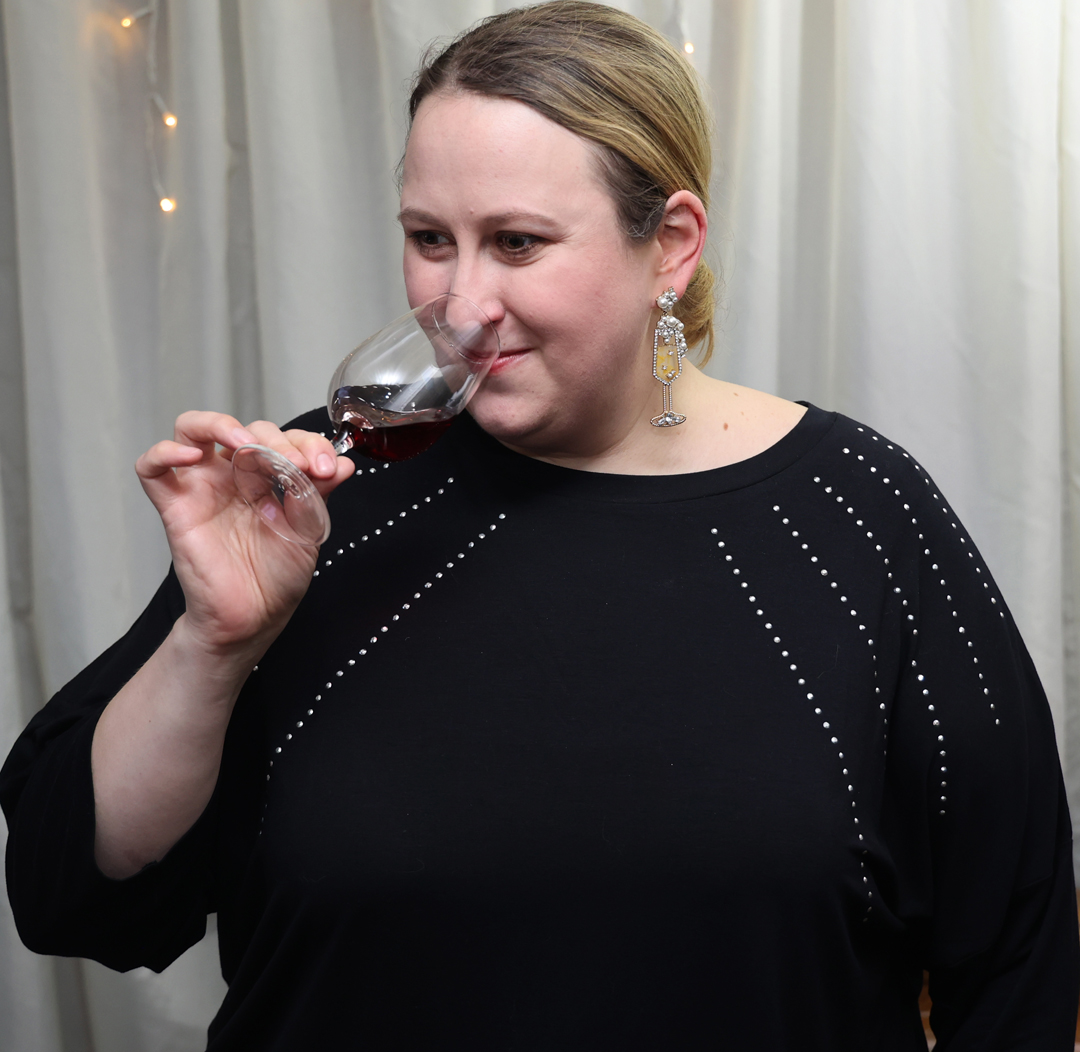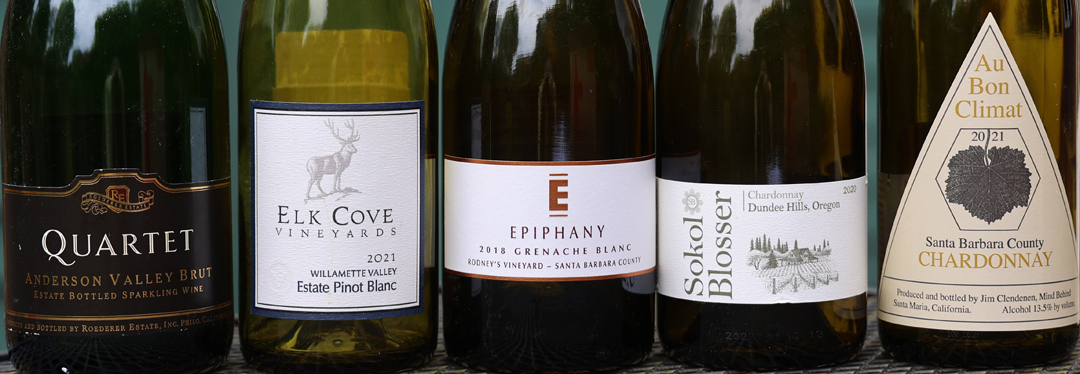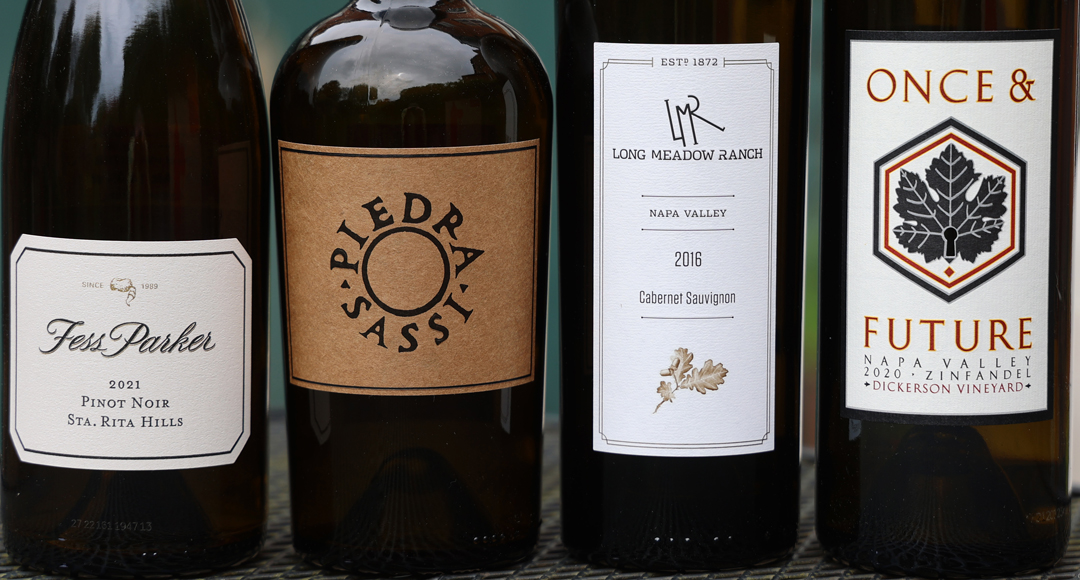 A wonderful tasting of wines from the Wine Society’s portfolio, illustrating the effects of terroir on the choice of grape variety in California and Oregon and contrasting wine making techniques. A sparkling wine (Quartet Anderson Valley Brut, Roederer Estates NV) was the entry wine followed by four pairings:
A wonderful tasting of wines from the Wine Society’s portfolio, illustrating the effects of terroir on the choice of grape variety in California and Oregon and contrasting wine making techniques. A sparkling wine (Quartet Anderson Valley Brut, Roederer Estates NV) was the entry wine followed by four pairings:
- Elk Cove Vineyards Williamette Valley Estate Pinot Blanc 2021 versus Epiphany Santa Barbara
 Grenache Blanc 2018
Grenache Blanc 2018
- Sokol Blosser Dundee Hills Chardonnay 2020 versus Au Bon Climat Santa Barbara Chardonnay 2021
- Fess Parker Sta. Rita Hills Pinot Noir 2021 versus Piedrasassi Sta. Rita Hills Sebastiano-Patterson Vineyard Syrah 2017
- Long Meadow Ranch Napa Cabernet Sauvignon 2016 versus Once and Future Dickerson Vineyard Napa
 Zinfandel 2020.
Zinfandel 2020.
The presenter, Sarah Knowles, who has responsibility for wine buying at the Wine Society for Champagne and Italy as well as North America, also discussed her ‘wine journey’ from geography undergraduate to MW.
For details of the tasting please click through.
[weblink to main tasting report]
A spectacular tasting and an inspiring presenter. Thanks to the generosity of the Wine Society we were able to taste a remarkable range of North American wines chosen by @Sarahthewinebuyer.
Sarah Knowles mixed stories and insight from her own personal journey into the world of wine (‘exciting, exacting – and very poorly paid!’) with illuminating commentary on the wines she had chosen. The politics of family businesses, Californian fogs and their role as fridges, the importance of finding mortgage-free wine-makers, the freedom given to WS buyers to list only those wines that they believe offer value – and that they themselves would buy (and do buy). All this and more in a packed two hours.
Having won a hockey blue, Sarah gave it up because (she said) the social side of Oxford sport was taking up too much time from her geography course – and joined first the Wine Circle and then the Blind Wine Tasting group. From the start she was hooked by the intricacies of blind tasting – and from the start she was clearly a spectacular star. Part of the winning Oxford team in the Pol Roger contests against first Cambridge and then a French team, James Simpson MW of Pol Roger said ‘you need to become an MW’. So she did. Work experience along the way in France, Chile, Australia, New Zealand and Oregon demonstrated the generosity of the wine trade, persuaded her that wine making was not her calling (‘soft hands’) and set her en route to her present role as buyer for Champagne, Italy and North America.
The first wine of the evening was the Roederer Estate’s non vintage Quartet Anderson Valley Brut. Made in a mountain enclave opening out to the Pacific planted up by Roederer and others in the early 1990s this is a 60/40 Pinot Noir and Chardonnay blend that draws on as much as 40% of reserve wine stocks. Reserve wine is the secret weapon of sparkling wine producers and it was encouraging to hear that English producers are steadily building their stocks – which means there should be a steady improvement in the quality of the house blend. There’s not so much Pinot Meunier in the Anderson Valley as in Champagne and there’s a mix of champagne and burgundian clones. Two years on the lees and several years of bottle ageing make for a rich, creamy wine with clean fruit, yeasty / nutty notes and great freshness. Then came a pair of west coast whites with very different styles.
First of a contrasting pair of white wines was Elk Cove’s Willamette Valley Estate Pinot Blanc from 2021. Oregon’s wine industry – as Mark Savage has told us in previous tastings – was dominated from the start by a ‘plant a row or two of everything and see what works’ approach. It’s easy to make the assumption that Oregon is too far north for properly ripening grapes but in fact it’s pretty much the same latitude as central France. Pinot Blanc, given cool night air and good sunshine, works a treat. Elk Cove’s winemaking showcases both freshness and aromatic richness and this example from 20 year old vines displayed nectarine and peaches on the nose with decent acidity and a sense of richness. The Wine Society suggest this needs drinking by 2024 – but Sarah did say that the Society are always super-cautious with their drinking windows. ‘We are a retailer after all and don’t want you to blame us for out of condition wine’ – so the end date is their view of when the fruit will start to fade. But if you have a taste for the bouquet that comes with older wines then you can afford to take them with a pinch of salt.
Wine no 3 was from the Santa Barbara vineyards of southern California. Fess Parker’s success as Davy Crockett in the Hollywood movies made him rich and famous and when he retired from acting the money went into growing vines (unlike many US producers who buy in grapes farmed by others) and making wine. The business is now run by his children and grand-children – and here Sarah hinted at the need to keep on top of family ‘politics’ and the importance of getting to know each succeeding generation.
The Parker estate’s Epiphany Santa Barbara Grenache Blanc 2018 reminded some members of Riesling with the whiff of petroleum (or the waxy/lanolin of old vine Semillon). 20% of new oak adds to the slightly funky, almost feral, character of the grapefruit peel nose. Lots of energy and attack in this wine – and sufficient acidity and structure to age for 5-10 years whilst gaining aromatic complexity. Some (limited) oak influence and fairly high alcohol at 13%.
Responding to a question Sarah talked of the difference between ‘linear’ wines and those which sit more horizontally in the mouth. Linear wines are those which deliver a single-minded intensity with, hitting the same spot on the palate from start to finish. More horizontal wines are those with more dimensions – spreading out to offer different sensations on the palate and in the mouth.
Next up came a pair of Chardonnays – again matching up Oregon vs. Santa Barbara and again offering different takes – with preferences changing as we tasted and re-tasted the wines over the space of 10-15 minutes.
In the Oregon corner was the Sokol Blosser Dundee Hills 2020 Chardonnay. Bill and Susan Sokol Blosser planted their first wines in the Dundee Hills area in 1971 on red volcanic soil that had been the home of redwood forests. The soil is fairly infertile – so ideal for vines – but the land itself needed major ‘engineering’, meaning dynamite and big machinery to clear out the root systems left behind after the lumberjacks had moved through. The wine itself was delicate, precision made, with peach and apricot rather than green apple aromas overlaid with some salinity and a hint of warm vanilla from a degree of French oak fermentation and ageing. Probably another five years of good drinking for this one – but after that the fruit may begin to fade.
In the Californian corner, was Au Bon Climat’s Santa Barbara 2020 Chardonnay. The late Jim Clenenden who founded ABC in the early 1980s had become fascinated by wine on a visit to Burgundy and his approach to viticulture reflected this with Burgundian clones, 100% barrel fermentation in old French oak and the use of batonnage and wild yeasts to add complexity. On first sniff it seemed paler, less compelling that the Sokol Blosser but as it opened in the glass layers of complexity were revealed. Intense citrus and stone-fruit aromas with a touch of that reductive ‘struck match’ effect. In Sarah’s view this was a wine that would improve for another five years and then hold for at least another five years.
Then came the first two pairs of reds.
Fess Parker’s Santa Rita Hills 2021 Pinot Noir (14.5% abv) was served with the Piedrasassi Santa Rita Hills Sebastiano-Patterson Vineyard 2017 Syrah. Both these wines show high levels of typicity and Sarah strongly urged us that one of the best ways to build up our tasting skills is to taste one wine against another – blind! Thankfully she did not insist on this with the Club. Parker’s Pinot Noir was all clean red fruit (raspberries, strawberries, red and blackcurrants). French oak and 10-15% of whole bunch fermentation add complexity. The whole bunch fermentation (which demands hand-picked fruit) adds complexity to the flavours and makes for greener / stalkier tannins. This wine comes from one of the cooler sites of Parker’s vineyards – thanks again to all-night fogs – hence the remarkable freshness. Another keeper in Sarah’s view though some members wondered if there was enough structure for real longevity.
The Syrah was a very different beast. In Sarah’s view this was the possible ‘marmite’ wine of the tasting. indeed one Wine Society member’s response to this wine was ‘sack the buyer!’. Not for our members though. Winemaker Sashi Moorman’s approach is deeply influenced by the Northern Rhone. Like many of the smaller west coast producers, the family buy in their grapes and the wine is then made in small batches at Lompoc. Any tasting note that starts with stressing the initial hit of bacon or prosciutto (very reminiscent of Frazzles for those a taste for salty snacks) runs the risk of diminishing the stature of a fine wine that shows intensely floral and black pepper notes on the nose, dark fruit in the mouth and then leathery / gamey notes as the wine develops in the glass. Yet it carries its freshness through into a long, long finish.
Sarah’s final choice was to showcase two iconic Californian grapes: Cabernet Sauvignon and Zinfandel. The very first of her Wine Circle meetings had featured the wines of Chateau Kirwan. At that point she knew nothing of Bordeaux blends but the region fascinated her so much that she found her first wine job there – living in the ‘very grand’ West wing bedroom of Chateau Issan next door to Kirwan and dong whatever menial jobs were thrust upon her. But she was already hooked and Cabernet remains one of her (several) vinous obsessions.
The Long Meadow Ranch Cabernet Sauvignon of 2016 was the tastings only representative form the Napa but this was a wine not of the increasingly hot valley floor but of the hills. If you can’t get enough fog, go high! The Hall family ranch encompasses vineyards, olives and pasture in the hills to the north of Napa itself. Their still youthful wine opens with a bang - a big nose of plums, blackberries and a touch of menthol. Slightly smokey with a touch of licorice in the finish.
The final wine of the tasting was the Once and Future Dickerson Vineyard’s 2020 Zinfandel. For many members this was perhaps the surprise of the evening. Zinfandel links to southern Italy’s often pretty rustic Primitivos. Emigrants to America brought bundles of mixed vines with and their ‘mixed black’ rows of Alicante, Primitivo, Petit Syrah, Petit Verdot, Primitivo and the like were prized for their ability to deliver a balanced wine. Now Joel Dickerson makes a seriously classy 100% Zinf from ungrafted 110 year old vines grown on sandy soil (water hungry but phylloxera resistant). Red fruit notes of raspberries and red apple were overlain with distinctive notes of chocolate and coffee from its maturation in old redwood barrels and leading into a long and mint-tinged finish.
Both these wines, in Sarah’s judgment could take another twenty years of ageing and development. So, support the Wine Society, buy a box of each and ration your tasting… And, if you’re not a member think about joining. Every extra member (even if it’s two or more from a single household) adds to the buying power of Sarah and her colleagues.
Listening to Sarah it was clear why she is now a tutor for MW candidates and a mentor to so many women in wine. No wine b-s here, only clear and memorable expressions of her own enthusiasm for the way wine is shaped by the patterns of the land and climate (her geography degree finally earning its keep), by the nature of the soil and by personalities and passions of its makers.
A memorable tasting … and to reflect it at home you need naught but a Wine Society membership!
GH: 28/4/23